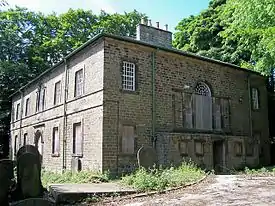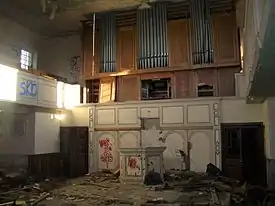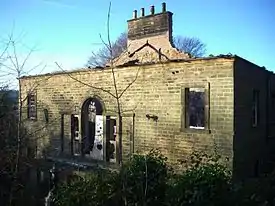Loxley United Reformed Church
Loxley United Reformed Church is a derelict Grade II* listed building located on Loxley Road in Loxley, a western suburb of the City of Sheffield, England. It is currently in a fire damaged state.



History
The building was originally known as the Loxley Congregational Chapel and was constructed in 1787 at a cost of £1,000 by some of the worshippers at the Church of St Nicholas, Bradfield. It was built for the curate at St Nicholas’ Benjamin Greaves who was about to be dismissed and his parishioners wanted him to stay in the area. Upon completion the chapel, which was set back 100 metres from Loxley Road had the look of a large house constructed from squared gritstone with Venetian windows. The local Bishop was asked to consecrate the building upon its opening but refused because it did not have an east window. In its early years the church was utilised as an Anglican place of worship with Benjamin Greaves continuing to preach until he was appointed to a new post at Stoney Middleton.[1] Mr Greaves was succeeded by a Church of England minister, the Reverend Flockton. By1798 the building was being rented by Protestant Dissenters or Independents and they changed its name to The Loxley Independent Church when they bought the building outright. In 1802 the Independents appointed their first minister Daniel Dunkerley, who was incumbent for 18 years until his death, he was buried in the churchyard.[2]
David Dunkerley was the next minister, he was no relation to Daniel, remaining until he emigrated to Canada in 1830. Reverend Cullen (1830-1836) was succeeded by the Reverend John Hanson, known as the "Vicar of Loxley", who was minister for 18 years. Thomas France was minister for 35 years (1854-1889) eventually dying in November 1898, aged 83. Parishioners placed a remembrance tablet to him in the church. According to the Religious Census of 1851 an average congregation at an afternoon service was 200 people. A new school-room and minister's house was built in 1855, the first stone being laid on 30 April by Alderman Francis Hoole, Esq. former Lord Mayor of Sheffield.[1] Many victims of the Great Sheffield Flood of 1864 were interred in the churchyard including memberes of the Armitage, Bower, Crownshaw, Denton, Bates, Hudson and Chapman families.[3] In 1872 Henry Tingle Wilde, Chief Officer of the RMS Titanic was christened at the church. In the 1970s the name of the church was changed again to the Loxley United Reformed Church due to the formation of the United Reformed Church in 1972.[4]
Modern times and 2016 fire
The church closed in 1993 with the building gradually deteriorating into a ruinous state over the years. The churchyard which surrounds the church on three sides became overgrown. Despite efforts to keep the interior secure, people broke into the church and caused substantial vandalism. In the early hours of 17 August 2016 the church caught fire and was severely damaged by the flames. The fire was attended by three fire engines and was put out within hours, however the building was completely gutted, losing its roof and first floor and all its fitments, it now stands open to the elements as of early 2020.[5]
References
- Around Bradfield, Loxley and Hillsborough, Malcolm Nunn, Chalford Publishing, 1996, ISBN 0 7524 0671 X, Historical Details.
- National Archives Gives some history. Retrieved 8 January 2017.
- Mick Armitage Sheffield Flood Site Locations of flood victims graves. Retrieved 8 January 2017.
- Historic England. "Details from listed building database (1314565)". National Heritage List for England. Retrieved 8 January 2017. History and Architecture.
- Sheffield Star Newspaper Gives details of fire. Retrieved 8 January 2017.